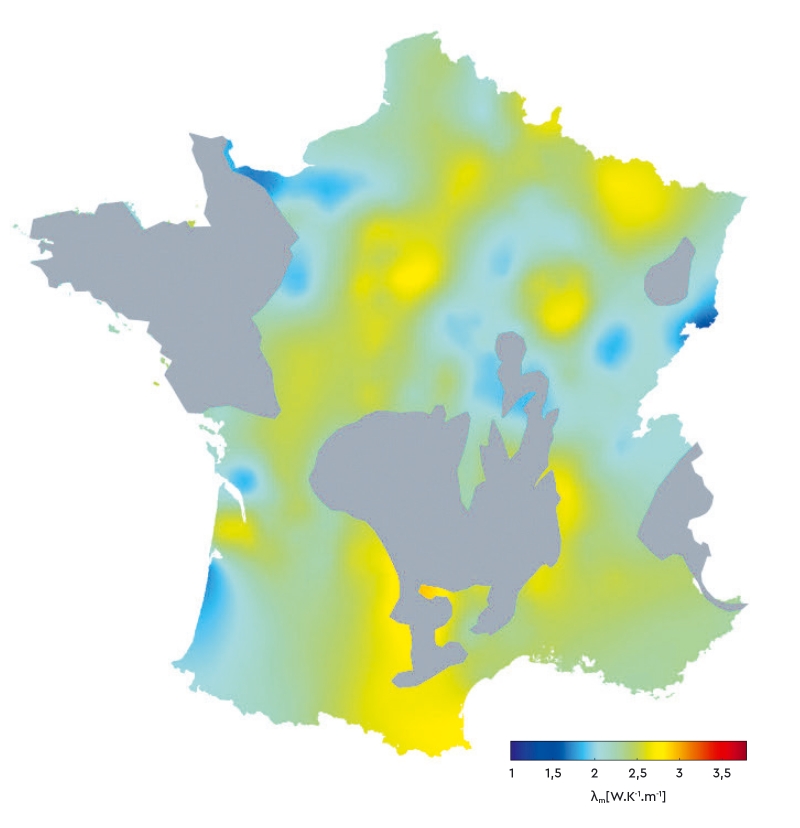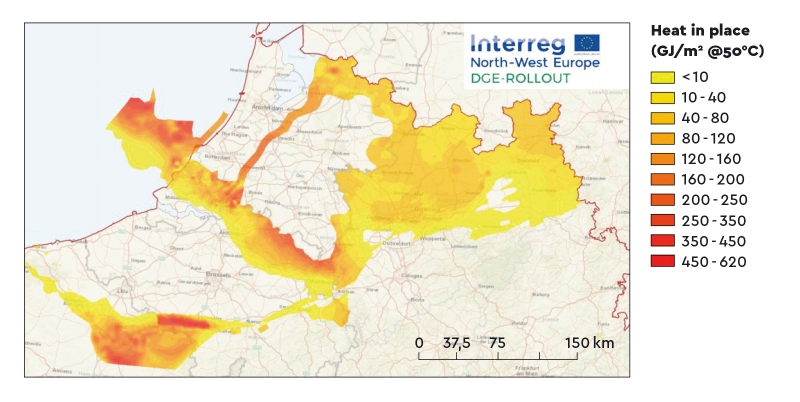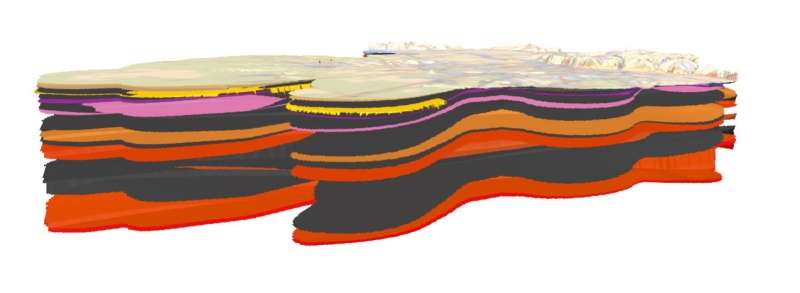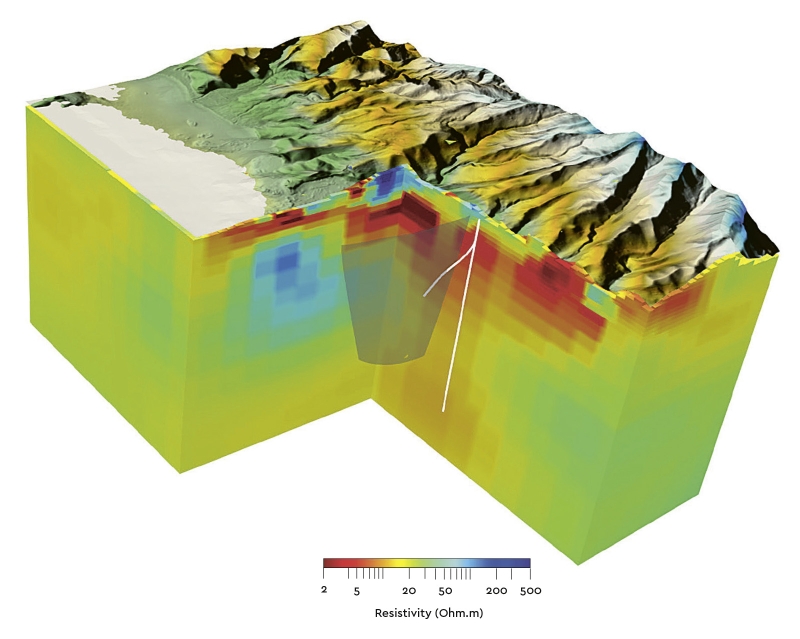Estimation of the thermal conductivity of the subsurface over a depth of 100 m, one of the parameters required to calculate an energy label for the subsurface (shaded areas currently being assessed). © BRGM
Subsurface potential for the energy transition
In brief
New studies to promote the development of geothermal energy in france
As part of the government's plan to accelerate the deployment of geothermal energy, BRGM signed a multi-year agreement with the French government in 2023, covering a number of studies. A national deep geothermal inventory has thus been launched, with the aim of characterising deep geothermal targets more precisely. This tool should encourage project owners and operators to follow suit. BRGM has also begun to draw up a national map of energy labels for the deployment of vertical geothermal probes. The aim is to encourage the deployment of this technology, particularly for small-scale operations.
HyLife and microbial impacts on hydrogen storage
To guarantee the safety, efficiency and economic viability of its underground storage, it is crucial to understand the impact on hydrogen (H2) of the many micro-organisms naturally present underground and likely to feed on it. The HyLife project, launched at the end of 2023, involves establishing a European overview of the diversity and activity of these micro-organisms, through the analysis and characterisation of several potential storage sites throughout Europe (salt caverns, aquifers, depleted reservoirs). The aim is to identify key factors and select the most favourable sites.
MIMAROC: the platform is operational
A BRGM laboratory, the MIMAROC platform, was inaugurated in 2023. It combines in situ experimental cells and digital image analysis resources for in operando monitoring of thermo-hydro-mechanical-chemical (THMC) processes. The THMC models developed in this way will enhance the ability to predict changes in underground systems on the time-scales needed to assess the safety of the technologies studied, particularly for geothermal energy and CO2 storage.
Supporting the expanded use of deep geothermal energy in North-Western Europe
Bringing together France, Germany, the Netherlands and Belgium, the DGE-ROLLOUT project (2019-2023) aims to promote the use of deep geothermal energy in Dinantian limestone (Carboniferous) for district heating networks. Focusing on the Hauts-de-France region, BRGM has studied the potential for deep geothermal energy, including surface needs, in order to identify areas that are favourable for deploying this technology. Based on these results, Engie Solutions has proposed a geothermal energy project for the Renault plant in Douai, enabling 67% of its thermal needs to be decarbonised.
Heat in place map for the Dinantian reservoir in North-West Europe. © BRGM
CO2-dissolved; towards industrial and commercial deployment
The CO2-Dissolved project has entered a new phase. Following a positive technical and economic assessment of the concept, which combines the storage of dissolved CO2 in an aquifer and the recovery of geothermal energy, a new partnership agreement has been signed between BRGM, SLB and Sageos to develop an initial commercial pilot. Two sites are being considered, in Centre-Val de Loire and Île-de-France, where pre-feasibility studies will begin in 2024. This first pilot could be operational within two to five years.
Developing surface geothermal energy in the greater bordeaux area
Between 2018 and 2023, BRGM worked with Bordeaux Métropole, with the support of Ademe, on an R&D programme to develop surface geothermal energy in the area. An online application was created to provide information on geothermal resources in the first few hundred metres of depth. A study of the potential for covering the needs of buildings using geothermal energy was also undertaken, but it was not possible to assess this due to a lack of data. Finally, support for project sponsors has enabled many geothermal facilities to be set up in the region.
... and the chartres metropolitan area
Near-surface geothermal energy could cover up to 36% of Chartres Métropole's heating and domestic hot water needs. This is the conclusion of a BRGM study which, together with the Buildings Scientific and Technical Centre (CSTB), involved estimating the needs of buildings and assessing the energy potential of near-surface geothermal energy (assisted by heat pumps) in the region. The maps produced combine subsurface characteristics, building requirements, land zoning and regulatory constraints and urban density.
Geological model of the Bordeaux Metropolitan area representing the subsurface to a maximum depth of 660 m. The layers shown are: in colour, the roofs of the main aquifers that make up the aquifer geothermal resources; in black, the roofs of the main low-permeability formations. © BRGM
Caribbean: two innovative geothermal exploration methods
As part of the Energy Transition in the Caribbean programme (Interreg V - TEC 2019-2023), BRGM has developed a new approach to geophysical exploration in Guadeloupe - subsequently exported to Saint-Vincent - based on a combination of suitable electromagnetic methods. This was used to assess the offshore continuity of the Bouillante geothermal reservoir. BRGM also carried out the first known study of the geochemistry of geothermal waters on the islands of Guadeloupe, Martinique, Dominica, Montserrat and Saint Lucia, one of the main outcomes of which was to improve estimates of the temperature of geothermal reservoirs. BRGM has also submitted a report to the French Parliament on the geothermal potential of the islands of Guadeloupe, Martinique, Réunion, Mayotte and Saint-Pierre-et-Miquelon.
Resistivity model around the Bouillante power plant, revealing a potential geothermal reservoir. The model was produced for the first time using a joint land-sea electromagnetic acquisition method.









